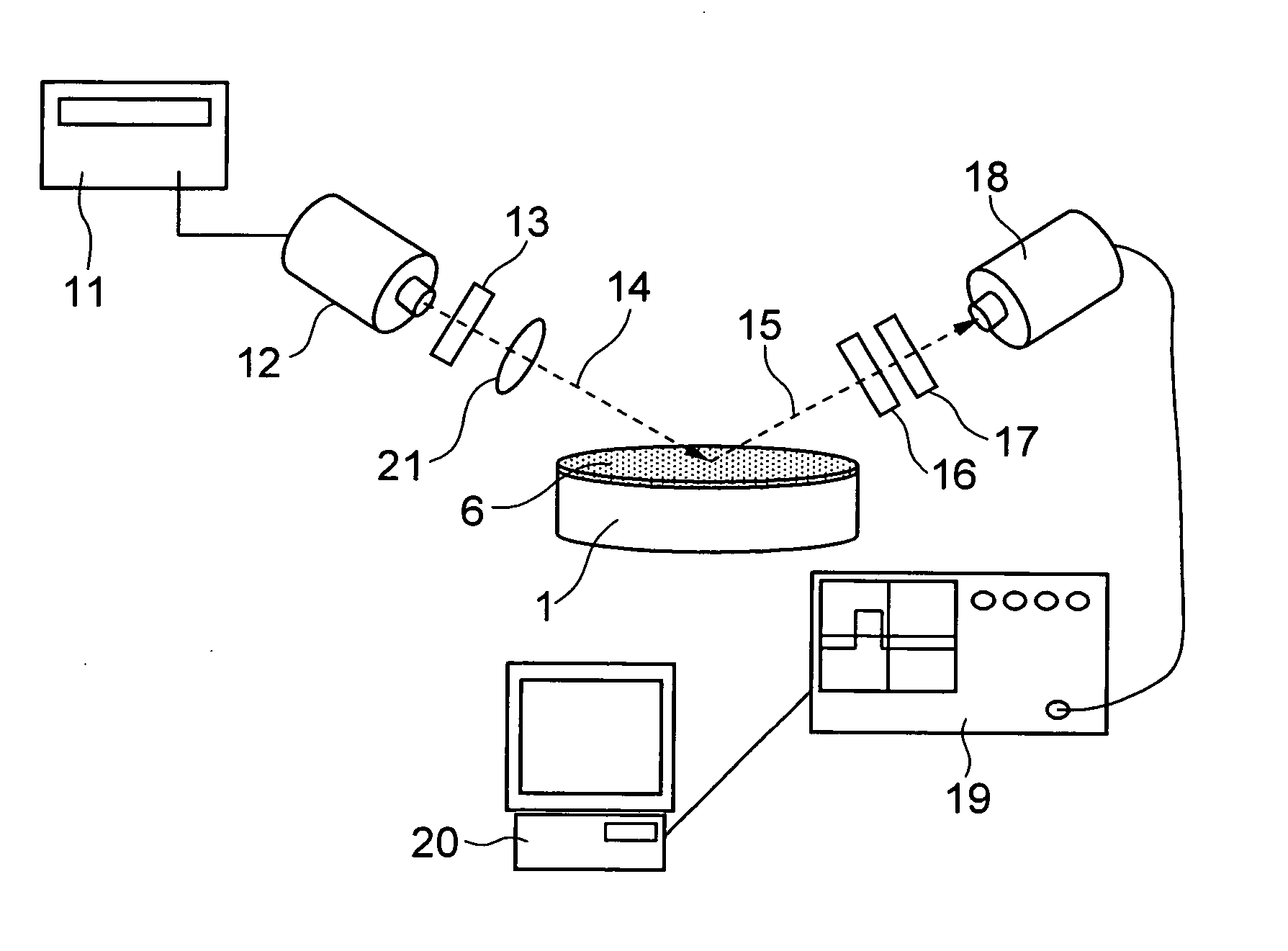Optical information recording medium, manufacturing method of the same and optical information recording and reproducing apparatus
a manufacturing method and optical information technology, applied in mechanical recording, instruments, transportation and packaging, etc., can solve the problems of increasing the storage capacity of the current 23.3 gb optical disc for the blue laser, becoming more difficult than ever to develop inexpensive laser diodes or semiconductor lasers, and achieving low power consumption , the effect of large storage capacity of the optical information recording medium
- Summary
- Abstract
- Description
- Claims
- Application Information
AI Technical Summary
Benefits of technology
Problems solved by technology
Method used
Image
Examples
embodiment 1
[0074]FIG. 1 is a schematic cross-sectional view of an optical disc in accordance with an embodiment of the present invention. In FIG. 1, a reference numeral “1” denotes a substrate, “2” denotes a reflecting layer, “3”, “5” and “7” denote protective layers, “4” denotes an optical information recording layer, “6” denotes a super-resolution layer, “8” denotes a cover layer, “9” denotes a groove, and “10” denotes a land. A laser beam for information read / write is applied to the optical disc from its cover layer side to focus on the surface of the substrate, by which information can be recorded on the optical information recording layer 4 as well as reproducing the recorded information.
[0075] A laser beam having a wavelength of 405 nm, emitted by an InGaN-based compound semiconductor laser as the light source, was used for the experiment. While the semiconductor laser generally emits the laser beam continuously, a pulsed laser beam (pulsed by a pulse generator according to recording in...
embodiment 2
[0115] Similar examination was carried out for other transition metal oxides. The following Table 2 shows the composition of super-resolution layers and oxygen gas flow ratios (in the whole gas) which were examined, together with the band gap energy Eg, the band gap wavelength λg corresponding to the band gap energy Eg, the difference (λ−λg) between the measurement wavelength λ and the band gap wavelength λg, the specific transmittance difference ΔT at the wavelength 405 nm, and the C / N ratio obtained by producing the optical disc shown in FIG. 1 and reading 0.05 μm pits. The oxygen gas flow ratio denotes the ratio of an oxygen gas flow (flow of oxygen gas) to a total gas flow (flow of the whole gas as a mixture of oxygen gas and Ag gas as the main deposition gas) in units %.
TABLE 2SUPER-RESOLUTIONOXYGEN FLOWSAMPLELAYER COMPOSITIONRATIO IN GASEgλgλ−λgΔTC / NNO.(MOLAR RATIO)(%)(eV)(nm)(nm)(%)(dB)10Fe2O302.704595412.83511Fe2O352.714575213.73612Fe2O3102.694615612.03413Fe2O3202.70459541...
embodiment 3
[0141] Another embodiment of an optical disc in accordance with the present invention will be described below. FIG. 24 is a schematic cross-sectional view showing an optical disc of this embodiment. In FIG. 24, a reference numeral “201” denotes a substrate, “202” denotes a reflecting layer, “203” denotes a protective layer, “204” denotes a super-resolution layer, “205” denotes an adhesive layer, “206” denotes a cover layer, and “209” denotes record pits. In the present invention, an Fe2O3—Ga2O3 thin layer was used as the super-resolution layer 204. The Fe2O3—Ga2O3 thin layer may be doped with heat-absorbing material such as Bi.
[0142] In this embodiment, optical discs were produced by depositing the thin layer materials on optical discs having a substrate 201 like the one shown in FIG. 24 on which a random signal pattern has been formed or on optical disc substrates exclusively for the C / N ratio test on which record pits and spaces have been formed at even intervals. In the optical ...
PUM
| Property | Measurement | Unit |
|---|---|---|
| transmittance | aaaaa | aaaaa |
| thickness | aaaaa | aaaaa |
| thickness | aaaaa | aaaaa |
Abstract
Description
Claims
Application Information
 Login to View More
Login to View More - R&D
- Intellectual Property
- Life Sciences
- Materials
- Tech Scout
- Unparalleled Data Quality
- Higher Quality Content
- 60% Fewer Hallucinations
Browse by: Latest US Patents, China's latest patents, Technical Efficacy Thesaurus, Application Domain, Technology Topic, Popular Technical Reports.
© 2025 PatSnap. All rights reserved.Legal|Privacy policy|Modern Slavery Act Transparency Statement|Sitemap|About US| Contact US: help@patsnap.com



